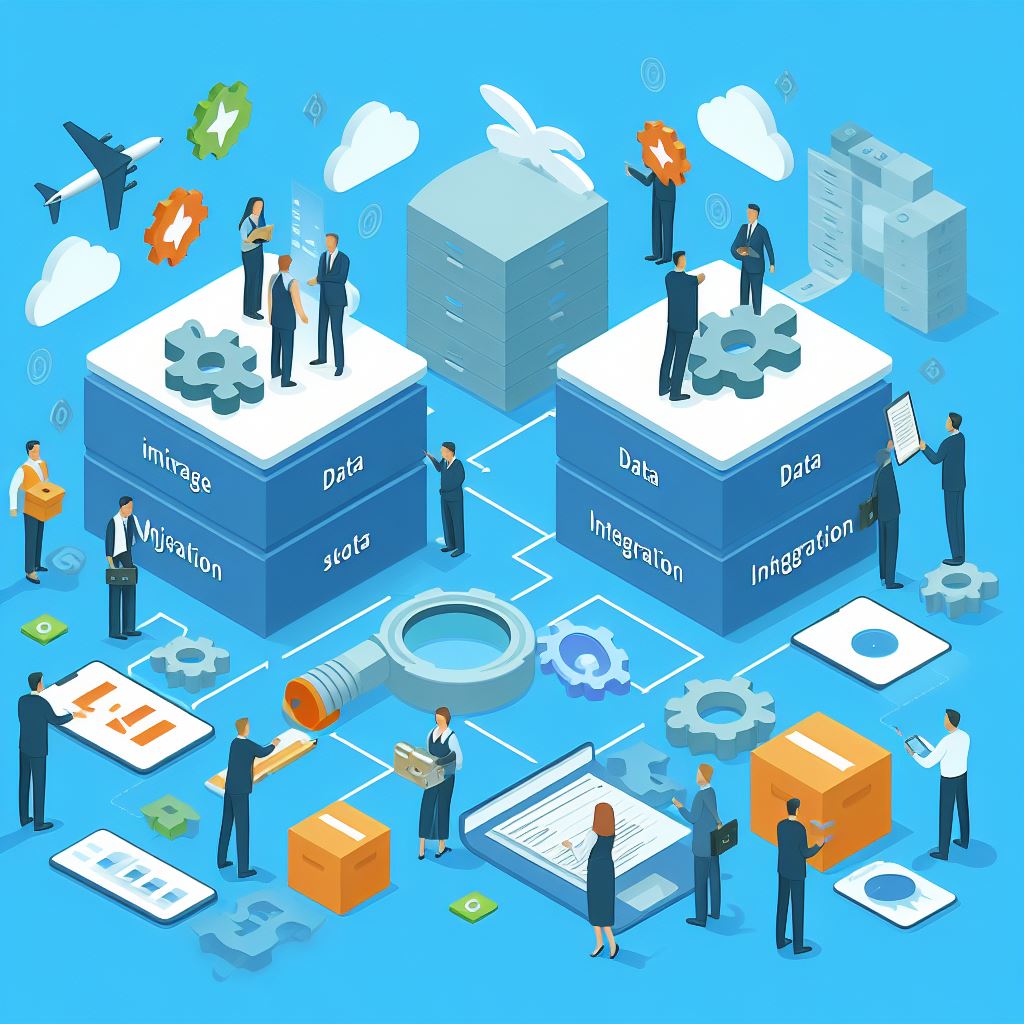Data plays a critical role in every organization. With the dynamic nature of technology, businesses often find the need to transfer data from one system to another or integrate data from multiple sources. This process is commonly known as data migration and data integration, which involves moving data from one location to another and combining various data sources into a unified format for effective analysis and decision-making.
Contents
- 1 What is Data Migration?
- 2 What is Data Integration?
- 3 Key Differences Between Data Migration and Data Integration
- 4 Best Practices for Effective Data Migration and Integration
- 5 Challenges in Data Migration and Integration
- 6 Frequently Asked Questions [FAQs]
- 6.1 Q: What is the difference between data migration and data integration?
- 6.2 Q: What are the best practices for data migration?
- 6.3 Q: What is the migration process for data?
- 6.4 Q: What is data mapping in the context of data migration and integration?
- 6.5 Q: What is the role of an integration strategy in data migration and integration?
- 6.6 Q: What are some common similarities and differences between data migration and integration?
- 6.7 Q: When should a company consider cloud data migration?
- 6.8 Q: How can organizations test the data migration process?
- 6.9 Q: What are some recommended data integration tools for businesses?
- 6.10 Q: What is the significance of establishing a data migration plan?
- 7 Conclusion
What is Data Migration?
Data migration refers to the process of moving data from one system to another, typically involving the transfer of data from a legacy system to a new data warehouse or platform. It is a crucial aspect of modern organizations as it allows them to update their systems and leverage new technologies to improve efficiency and facilitate better data management.
Understanding the Importance of Data Migration
The importance of data migration cannot be overstated. It enables businesses to keep up with evolving technologies and ensures that valuable data is not left behind in outdated systems. It also allows organizations to maintain accurate and up-to-date information, which is essential for informed decision-making and sustainable growth.
Types of Data Migration Techniques
There are various techniques for data migration, including manual data entry, data extraction and loading (ETL), and migration via specialized tools and software. Each technique offers distinct advantages and challenges, and selecting the most suitable approach depends on the specific requirements and complexity of the migration process.
Best Practices for Smooth Data Migration
Implementing best practices during the data migration process is essential to ensure a smooth transition. Data cleansing, transformation, and ensuring data security are critical aspects that need to be carefully managed to avoid any disruptions in the migration process.
What is Data Integration?
Data integration is the process of combining data from different sources into a unified format, often with the objective of providing a comprehensive view of the data for analysis and decision-making purposes. It involves integrating data from multiple sources, such as databases, applications, and cloud services, to provide a cohesive and holistic view of the organization’s data.
Exploring the Data Integration Process
The data integration process involves identifying relevant data sources, extracting the data, transforming it into a standardized format, and loading it into the target system. This ensures that the integrated data is consistent and accessible for accurate analysis.
Data Integration vs. Data Migration: Understanding the Differences
While both processes involve managing data, data migration and data integration serve different purposes. Data migration focuses on the movement of data from one system to another, while data integration emphasizes bringing together data from diverse sources to create a unified and cohesive view.
Challenges Faced in Data Integration
One of the key challenges in data integration is ensuring data quality and consistency across various sources. Handling large volumes of data from disparate sources and ensuring that the integrated data is accurate and reliable can be a complex task requiring careful planning and execution.
Key Differences Between Data Migration and Data Integration

While data migration involves transferring existing data from one system to another, data integration focuses on combining data from multiple sources into a unified format. Both processes require meticulous planning and execution to ensure a seamless transition and reliable data management.
Data Conversion in Data Migration
Data conversion is a critical aspect of data migration, involving the transformation of data from one format to another to ensure compatibility with the new system. This process requires careful consideration of data structures and mapping to avoid any loss or distortion of information during the migration process.
Managing Data Quality in Integration and Migration
Ensuring data quality is crucial in both integration and migration processes. Organizations need to establish robust data quality standards and incorporate data cleansing and validation mechanisms to maintain data accuracy and consistency throughout the integration and migration phases.
Comparison of Data Management in Migration and Integration
While data migration focuses on the process of transferring data from one system to another, data integration emphasizes harmonizing data from diverse sources to provide a unified view. Both processes require effective data management practices to ensure that the data is accurate, accessible, and compliant with organizational requirements.
Best Practices for Effective Data Migration and Integration

Ensuring seamless data transfer requires a comprehensive understanding of enterprise data and consideration of key factors that can influence the migration and integration processes. Understanding the complexities of data migration and integration is essential for implementing best practices and achieving successful outcomes.
Understanding Enterprise Data: Key Considerations
Organizations should assess their enterprise data landscape, including the types of data, existing data structures, and the dependencies between different data elements. This understanding is critical for formulating a robust migration plan and integrating data to meet specific business objectives.
Streamlining the Migration and Integration Processes
Streamlining the migration and integration process involves selecting appropriate migration tools and integration platforms that align with the organization’s requirements. It also necessitates defining clear data transformation and validation processes to ensure that data is migrated and integrated efficiently and accurately.
Ensuring Seamless Transfer of Data
Ensuring a seamless transfer of data requires mitigating potential risks and disruptions that may arise during the migration and integration processes. Creating a comprehensive migration strategy, incorporating data validation checks, and conducting thorough testing are crucial to minimize the impact on business operations.
Challenges in Data Migration and Integration

Despite the benefits of data migration and integration, organizations often encounter challenges that need to be effectively addressed to ensure successful outcomes.
Addressing Data Quality Issues
Addressing data quality issues is a significant challenge in both data migration and integration processes, as the accuracy and consistency of data directly impact the reliability and usefulness of the integrated data.
Managing Large-Scale Data Migration
Large-scale data migration poses challenges related to handling massive volumes of data, maintaining data consistency, and ensuring minimal disruption to ongoing business operations. Comprehensive planning and robust execution are essential to manage the complexities associated with large-scale data migration.
Overcoming Integration Hurdles
Overcoming integration hurdles involves addressing technical complexities, data format disparities, and system compatibility issues. Organizations need to leverage advanced data analytics tools and employ effective data transformation techniques to overcome integration challenges and ensure seamless data integration across diverse sources.
Frequently Asked Questions [FAQs]
Q: What is the difference between data migration and data integration?
Data migration refers to the process of transferring data from one system to another, while data integration involves combining and unifying data from different sources into a single, coherent view.
Q: What are the best practices for data migration?
Best practices for data migration include thorough planning, data cleansing, testing, and documentation to ensure a smooth and successful transition of data to a new system.
Q: What is the migration process for data?
The migration process for data typically involves assessing the existing data, preparing the data for migration, executing the migration, and conducting post-migration validation and testing.
Q: What is data mapping in the context of data migration and integration?
Data mapping involves establishing a relationship between the data elements in the source and target systems to ensure accurate and complete data transfer during migration and integration.
Q: What is the role of an integration strategy in data migration and integration?
An integration strategy outlines the approach and techniques for harmonizing data from diverse sources to enable seamless data migration and integration, aligning with the organization’s goals.
Q: What are some common similarities and differences between data migration and integration?
Both data migration and integration involve handling data. Still, while migration focuses on moving data to a new system, integration concentrates on linking and consolidating data from diverse sources for a common purpose.
Q: When should a company consider cloud data migration?
Companies should consider cloud data migration when they aim to leverage the scalability, accessibility, and cost-efficiency of cloud infrastructure for storing and managing their data.
Q: How can organizations test the data migration process?
Organizations can test the data migration process by conducting trial runs, data validation, and performance testing to identify any errors or discrepancies and ensure the integrity of the migrated data.
Q: What are some recommended data integration tools for businesses?
Recommended data integration tools for businesses include ETL (Extract, Transform, Load) software, data virtualization platforms, and integration middleware solutions tailored to meet specific integration requirements.
Q: What is the significance of establishing a data migration plan?
Establishing a data migration plan is crucial as it provides a structured framework for defining objectives, assessing risks, allocating resources, and managing the entire data migration process in a systematic and controlled manner.
Conclusion
Mastering data migration and integration is a complex process, but with a step-by-step guide, it becomes manageable. This process is crucial in the modern world, where data is considered the new oil. Effective data migration and integration can lead to better decision-making, increased operational efficiency, and a competitive advantage. By following the guide you’ve discovered in this post, you can navigate the labyrinth of data migration with ease. Understanding and implementing these steps can pave the way for successful data management in your organization. Remember, in a world driven by data, mastering data migration and integration is not just an option – it’s a necessity. Are you ready to take control of your data migration and integration process?





